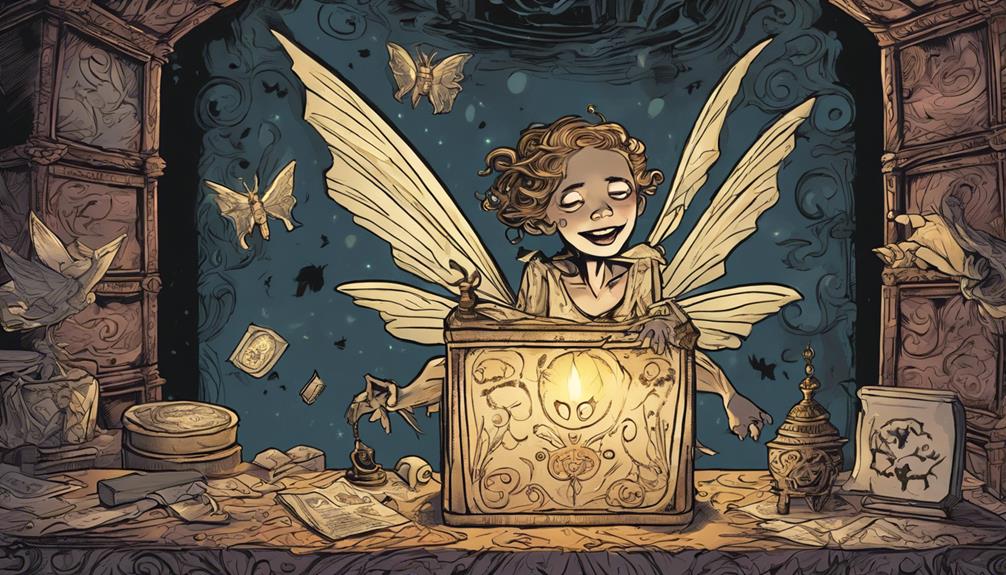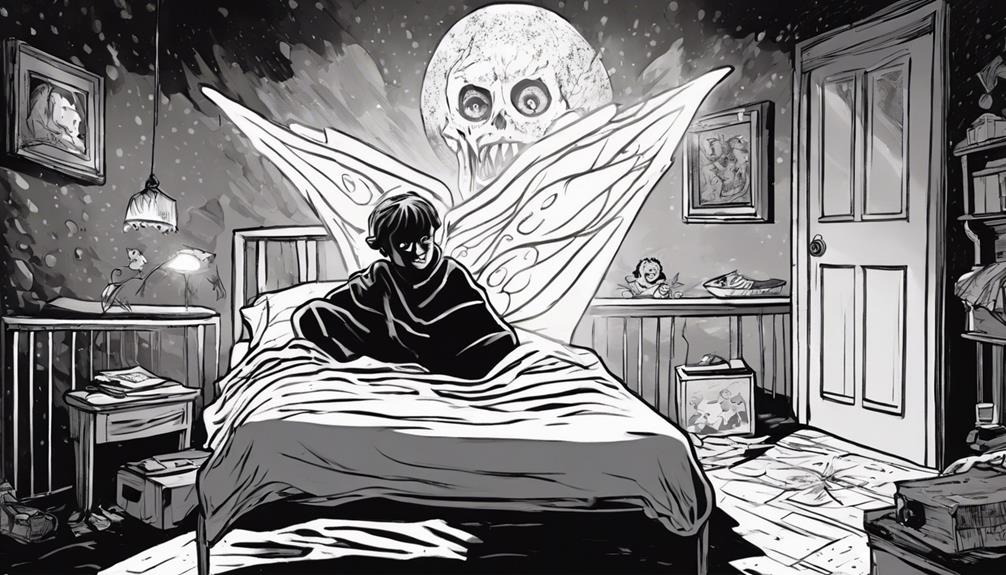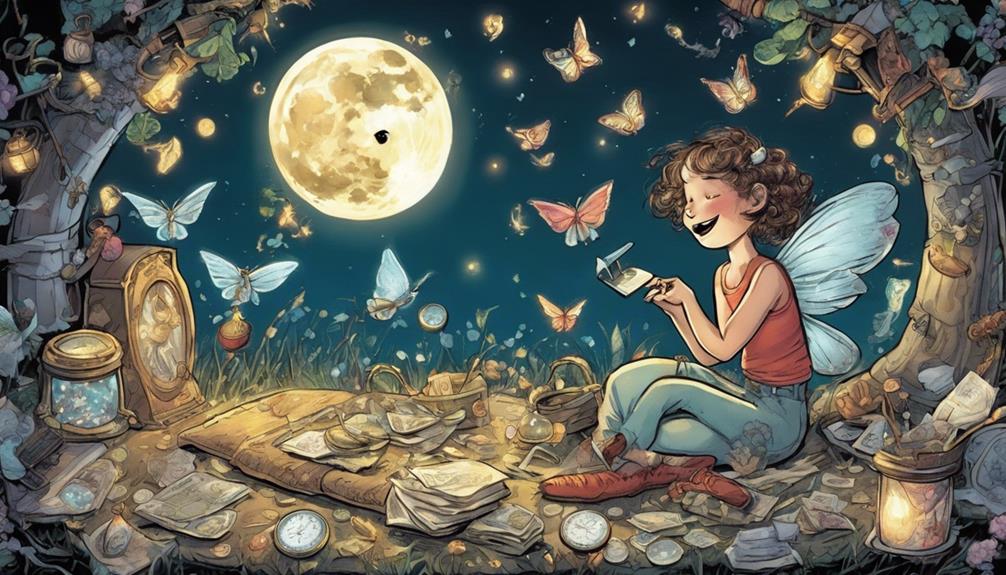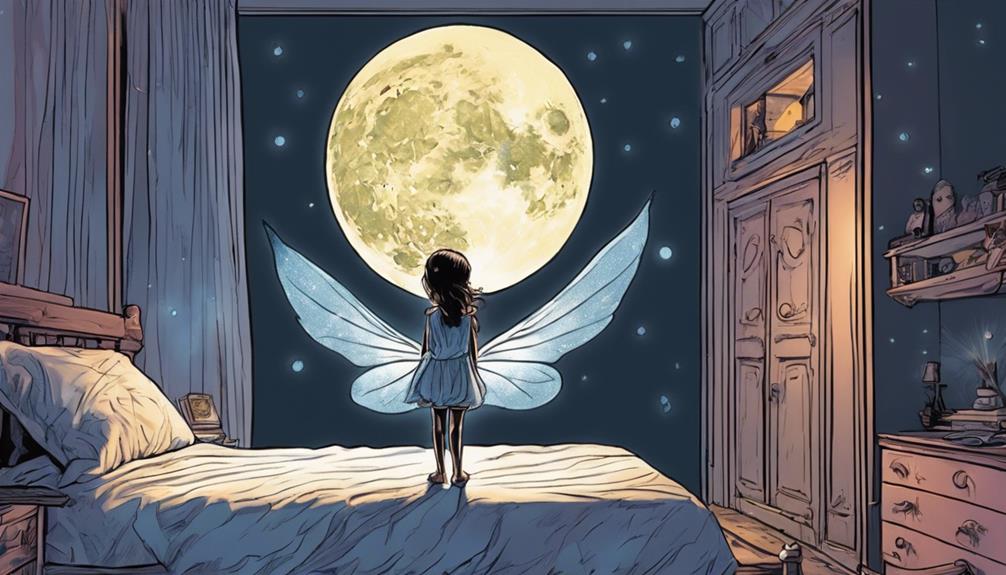The Tooth Fairy hides a mix of secrets that blend magic with the bittersweet reality of growing up. As she exchanges teeth for coins, she's tied to ancient customs meant to ward off evil spirits. While she encourages imagination, kids often face heartbreak when they discover her true nature. These revelations can spark feelings of sadness, embarrassment, and confusion, impacting trust in parents. Cultural variations add depth to her character, yet the shift from myth to truth can foster new family traditions. Stick around, and you might uncover the deeper layers of her enchanting facade and the emotional journey it inspires. Parents often play a pivotal role in preserving the mystery and wonder of the Tooth Fairy, utilizing the tooth fairy’s tools to create a sense of magic and whimsy for their children. Despite the potential for disappointment, the Tooth Fairy ultimately represents the fleeting nature of childhood and encourages resilience in the face of disillusionment. By embracing the complexities of the Tooth Fairy legend, families can find new ways to celebrate growth and change, creating lasting memories for generations to come.
Key Takeaways
- The Tooth Fairy myth originated as a protective measure against evil spirits, masking its darker historical roots in childhood fears.
- Cultural variations of the Tooth Fairy often involve rituals that reflect deeper anxieties surrounding tooth loss and childhood vulnerabilities.
- Disillusionment can lead to emotional turmoil for children, sparking feelings of betrayal and distrust toward parents when the truth about the Tooth Fairy is revealed.
- Parents grapple with the ethical dilemma of maintaining childhood wonder versus fostering honesty, potentially causing emotional fallout in their children.
The Tooth Fairy Myth Unveiled

The Tooth Fairy myth, while enchanting, has deep-rooted origins and cultural variations that reveal much about our beliefs and traditions surrounding childhood.
You might think of the Tooth Fairy as a whimsical character, but her history stretches back to ancient customs. In various cultures, people buried or burned lost teeth as a protective measure against evil spirits. This practice shows that the Tooth Fairy never started as a benign figure; instead, she emerged from the need for safety and security.
Over time, the myth evolved into the playful exchange of teeth for money or small gifts, a tradition many parents embrace to encourage imagination. You might find it fascinating how different cultures have unique takes on this myth, from leaving teeth under pillows to placing them in special boxes. These creative practices enhance the experience for children, making the act of losing a tooth a magical event.
While some parents worry about honesty and trust, they often choose to uphold the Tooth Fairy myth. This decision reflects a shared desire to nurture childhood wonder, even if it means keeping secrets about the Tooth Fairy's true nature.
Emotional Responses to Disillusionment
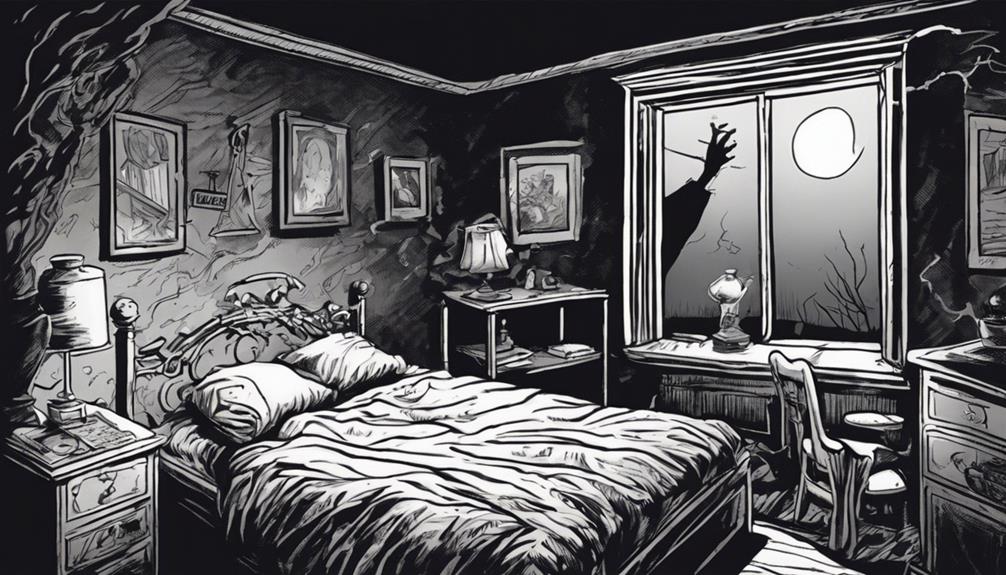
When you discover the truth about the Tooth Fairy, it's normal to feel heartbroken or disappointed.
As you navigate this shift from belief to reality, you might also question your parents' honesty, feeling a sense of betrayal.
Understanding these emotions is essential for both you and your parents as you adjust to a new perspective on childhood magic.
Heartbreak of Disbelief
Children often grapple with intense feelings of heartbreak and disappointment upon realizing the truth about the Tooth Fairy. This moment can be a painful shift, leaving them feeling foolish for having believed in something they once cherished. The emotional fallout can include:
- Crying: A natural reaction to the loss of belief.
- Embarrassment: Feeling silly for having trusted the myth.
- Sadness: Mourning the magic that once brought joy.
- Distrust: Questioning parents' honesty can create a rift.
These responses highlight how deeply children invest in the magical tales spun by adults. When the veil of belief is lifted, the resulting heartbreak can shape their views on honesty and trust.
As parents navigate these conversations, discomfort arises from wanting to protect their children while also fostering a sense of reality. Open discussions about magic can help ease this shift, allowing children to express their feelings and gradually understand the traditions surrounding mythical figures.
Ultimately, it's important to validate their emotions and reinforce that it's okay to feel heartbroken over lost beliefs.
Navigating Parental Honesty
Steering the delicate balance of honesty with your child can feel intimidating, especially as they grapple with the emotional fallout from disillusionment about the Tooth Fairy. When children discover the truth, they might experience sadness or embarrassment, feeling foolish for having still believed. This change can deeply affect their trust in you, creating a need for open dialogue.
To help navigate these feelings, consider fostering ongoing conversations about traditions and the magic of childhood. Here's a simple table to guide your discussions:
| Age Group | Common Reactions | Parental Approach |
|---|---|---|
| Younger Children | Confusion and curiosity | Encourage questions, provide gentle explanations. |
| Middle Childhood | Sadness and embarrassment | Validate their feelings, share your own experiences. |
| Tweens and Teens | Disappointment and skepticism | Promote critical thinking, emphasize the importance of tradition. |
The Role of Imagination in Childhood

Imagination fuels childhood development, sparking creativity and enhancing problem-solving skills. When you encourage your child's imaginative play, you're setting the stage for essential life skills.
Here are five key benefits of nurturing imagination:
- Fosters Creativity: Engaging in imaginative scenarios allows kids to think creatively and develop unique ideas.
- Improves Problem-Solving: Imaginative play challenges children to find solutions in different contexts, honing their critical thinking.
- Enhances Emotional Intelligence: Role-playing various situations helps kids understand and navigate their own emotions.
- Builds Social Skills: Interacting with imaginary friends or figures like the Tooth Fairy encourages empathy and perspective-taking.
Cultural Variations on Tooth Traditions

As kids around the world lose their teeth, various cultural traditions shape the way they celebrate this milestone, showcasing the rich tapestry of beliefs surrounding tooth loss. You might be surprised to learn that instead of the Tooth Fairy, many cultures have unique practices for dealing with lost teeth.
In Spain and parts of Latin America, children enthusiastically await the arrival of 'Ratoncito Pérez,' a small mouse that collects teeth in exchange for coins.
In some Asian cultures, such as India, kids bury their lost teeth in the ground, believing this will guarantee strong and healthy adult teeth.
Turkey has a similar tradition where kids toss their lost teeth onto the roof while making a wish for a healthy future.
Meanwhile, in Greece, children place their teeth under their pillows, expecting either the Tooth Fairy or a Tooth Mouse to leave a small gift or money.
These cultural variations highlight how communities around the world embrace tooth loss as a significant rite of passage, each with its own unique customs and beliefs.
Conversations About Belief and Truth

Talking with your kids about the Tooth Fairy can spark meaningful conversations about belief and truth, helping them navigate the line between magic and reality. These discussions often lead to valuable insights and emotional growth.
Here are some key points to reflect upon when you engage in these conversations:
- Younger children are often more inclined to believe, while older kids may question the existence of magical figures.
- Exploring their beliefs offers insight into how they perceive magic and reality.
- Emotional reactions to discovering the truth can include sadness and a sense of loss.
- Open dialogues foster trust, making it easier for kids to adapt to the truth about mythical figures.
Parental Dilemmas in Myth-Making

Steering the balance between nurturing childhood wonder and instilling honesty about myths like the Tooth Fairy can be a challenging dilemma for parents. You want to preserve the magic and wonder that these tales bring, but you also recognize the importance of transparency. As your child grows, they might start questioning the truth behind the Tooth Fairy, and guiding that conversation delicately becomes essential.
Emotional responses from children discovering the truth often include heartbreak and feelings of betrayal, which can influence their trust in you. It's common to feel pressured to uphold these myths, even if you're skeptical about their value. This conflict between maintaining the enchantment of childhood and fostering honesty creates parental dilemmas in myth-making that many face.
You might find that the traditions you create around the Tooth Fairy can help ease some of this tension. These family rituals can reflect your cultural background and personal beliefs about magic, allowing you to tailor the experience in a way that feels right for your family.
Ultimately, it's about finding a balance that works for you, ensuring your child feels both the thrill of imagination and the security of honesty.
Unique Family Traditions With Fairies

Creating unique family traditions with the Tooth Fairy can turn the experience of losing a tooth into a cherished memory that sparks joy and imagination. By incorporating personalized touches, you can deepen your child's connection to this enchanting figure and make the tradition even more special.
Here are some ideas for unique family traditions:
- Leave Notes: Encourage your child to write a letter to the Tooth Fairy, sharing their thoughts or asking questions.
- Tooth Collector: Introduce an alternative fairy or a 'Tooth Collector' that reflects your family's cultural background.
- Storytime Adventures: Share stories about the Tooth Fairy's adventures, stimulating your child's imagination.
- Creative Containers: Use decorated jars or special boxes to keep lost teeth, turning them into memorable keepsakes.
The Impact of Myth Exposure
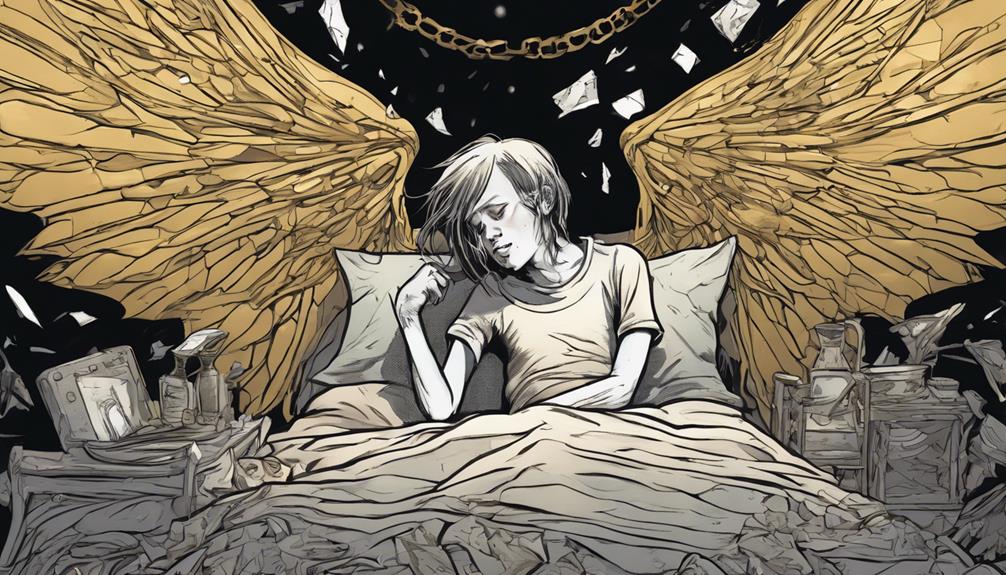
When children find out the truth about the Tooth Fairy, it can trigger strong emotional responses, like disappointment or heartbreak.
This disillusionment might make them question their trust in you and others, affecting their views on honesty.
As they process these feelings, it's essential to navigate the conversation with care to maintain that trust and transparency.
Emotional Responses to Disillusionment
Discovering the truth about the Tooth Fairy can leave many children grappling with intense emotions like heartbreak and disappointment. This disillusionment often comes with a wave of sadness, as they process the loss of a cherished belief.
You might notice your child reacting in ways that reflect this emotional turmoil, such as:
- Crying when they realize the myth isn't real
- Expressing feelings of betrayal or embarrassment
- Questioning other magical beliefs
- Searching for understanding about why the myth was created
These reactions highlight the emotional weight of disillusionment. As a parent, you might feel uncomfortable about the deception surrounding the Tooth Fairy, which complicates how you approach the topic.
Open discussions can help, but it's crucial to remember that each child processes these revelations differently. Older kids may question more deeply, while younger ones might still cling to the magic.
Ultimately, it's important to validate their feelings and allow them to express their disappointment, fostering an environment where they feel safe to explore the complexities of truth and belief.
Trust and Honesty Dynamics
The revelation of the Tooth Fairy's non-existence can greatly alter a child's trust in parents and their understanding of honesty. When you expose your child to the truth about mythical figures, they may feel heartbreak or embarrassment. This emotional response can lead to confusion and disappointment, impacting their perception of trust in you.
How you approach these discussions greatly affects your child's emotional resilience. If you create an open dialogue about the myth, you foster trust, allowing them to shift smoothly into reality while still cherishing the magic of childhood. Your honesty in these conversations can strengthen your bond, showing that while some beliefs may change, your love and support remain constant.
Younger children often struggle more with disillusionment, while older kids may navigate the complexities of truth and belief more easily. By addressing their feelings and acknowledging their sadness, you help them understand that honesty is an essential part of your relationship.
Emphasizing the spirit of childhood magic, even without the myth, allows your child to adapt and grow, ultimately reinforcing a foundation of trust grounded in honesty.
Exploring Future Parenting Approaches

Exploring new parenting approaches reveals a growing trend towards honesty and transparency, encouraging parents to rethink how they share childhood myths like the Tooth Fairy. You might find that many families are now balancing the magic of these stories with open discussions about reality. This shift is especially important when reflecting on the emotional responses of younger siblings, like your younger brother, who may feel heartbroken upon discovering the truth.
Here are some key points to reflect on:
- Fostering Trust: Honest conversations can create a stronger bond between you and your child.
- Emotional Support: Discussing the change from myth to reality can help children process their feelings.
- Cultural Influences: Different backgrounds shape how families perceive and celebrate these traditions.
- New Traditions: Creating unique family rituals allows for imagination while acknowledging the truth.
Embracing these modern approaches can help you foster a nurturing environment, allowing your children to thrive while still enjoying the magic of childhood.
Frequently Asked Questions
What Is the Dark Story Behind the Tooth Fairy?
You might not know that the Tooth Fairy's origins are rooted in ancient traditions where lost teeth were believed to protect children from evil spirits, and some even viewed her as a sinister figure collecting teeth for dark purposes.
How to Explain Tooth Fairy Isn't Real?
When your child finds a lost tooth, gently ask what they think about the Tooth Fairy. Share your own childhood experience, then explain it's a fun tradition, helping them shift while keeping the magic alive.
What Is the Original Story of the Tooth Fairy?
The original story of the Tooth Fairy stems from ancient traditions where lost teeth were buried or exchanged for coins. This practice evolved, becoming a whimsical figure who rewards children, fostering magic and excitement around losing teeth.
At What Age Should Kids Stop Believing in the Tooth Fairy?
Most kids start questioning the Tooth Fairy around ages 5 to 7. By age 8 or 9, many grasp the myth's fictional nature, often appreciating honesty while choosing to keep the magic alive for younger siblings.
Conclusion
As you tuck your child in, the glow of the nightlight casts a soft halo, almost like the magic of the Tooth Fairy herself.
You realize that, while her secrets may shadow the innocence of childhood, the stories you weave together ignite imagination and joy.
Embracing the myths, you create a world where wonder thrives, even as the truth looms.
In this delicate dance of belief, you strengthen the bond of trust that will guide them through life's enchanting mysteries.
